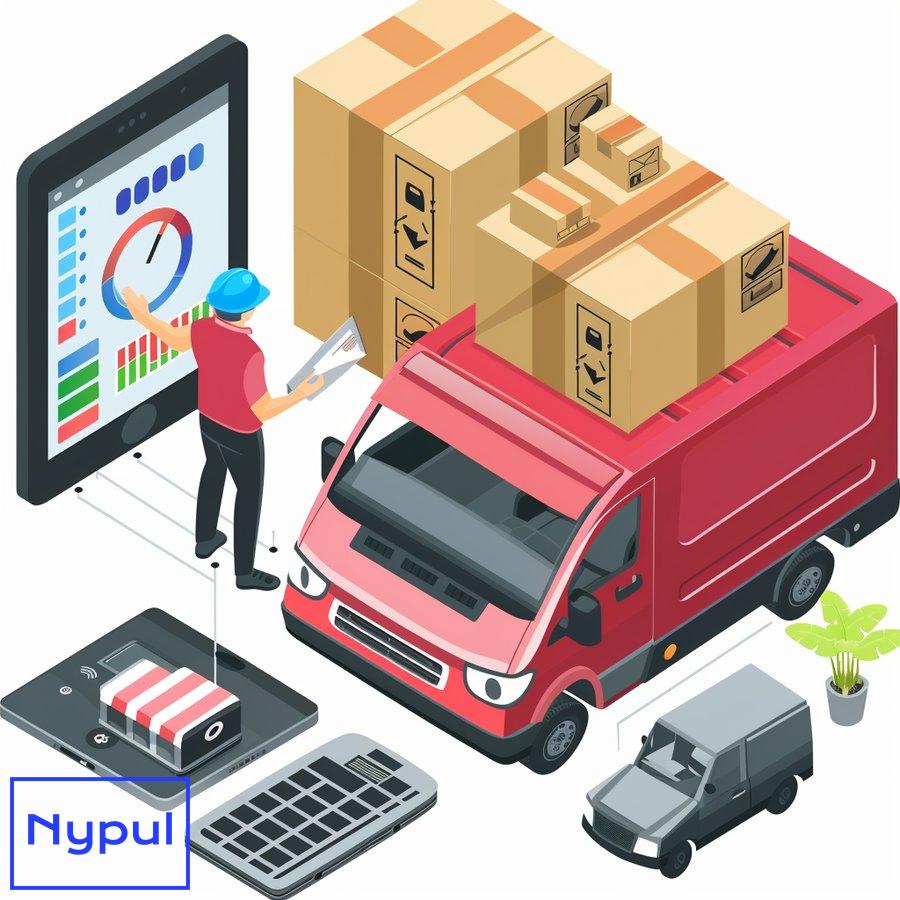How Is Delivery Efficiency Calculated
What is delivery efficiency?
Delivery efficiency refers to the effectiveness and timeliness with which a business can fulfill customer orders and deliver products or services. It encompasses various aspects of the logistics process, including transportation, warehousing, and order fulfillment. A high level of delivery efficiency is essential for maintaining customer satisfaction and ensuring repeat business.
Semantic Triples
- Delivery Efficiency: Effectiveness, Timeliness, Fulfillment
- Customer Satisfaction: Timely Delivery, Quality Service, Repeat Business
- Logistics Process: Transportation, Warehousing, Order Fulfillment
Delivery efficiency is not merely about speed; it also involves accuracy and cost-effectiveness. Businesses must balance these elements to optimize their delivery processes. Factors such as route planning, vehicle utilization, and inventory management play significant roles in determining delivery efficiency.
A well-optimized delivery system can lead to reduced operational costs, improved customer satisfaction, and a competitive advantage in the market. Companies that prioritize delivery efficiency often see enhanced performance metrics, leading to increased profitability.
Which performance indicators (KPIs) are used to measure delivery efficiency?
Key Performance Indicators (KPIs) are critical for measuring delivery efficiency, as they provide quantifiable metrics that help businesses evaluate their performance. Understanding these KPIs enables companies to identify areas for improvement and optimize their delivery processes.
Common KPIs for Measuring Delivery Efficiency
-
Number of Completed Deliveries: This metric tracks the total number of deliveries made within a specific timeframe. It serves as a foundational measure of delivery performance.

-
Order Accuracy: This KPI measures the percentage of orders delivered without errors. High order accuracy indicates effective order processing and fulfillment.
-
On-Time Delivery (OTD): OTD measures the percentage of deliveries made on or before the promised delivery date. This metric is crucial for maintaining customer satisfaction.
-
Average Time Per Delivery: This KPI calculates the average time taken to complete a delivery. It helps assess the efficiency of delivery routes and processes.
-
Average Cost of Delivery: This metric evaluates the total cost associated with delivering goods, including fuel, labor, and vehicle maintenance. Understanding this cost helps businesses optimize their budgets.
-
Transit Time to Distance Ratio: This KPI assesses the efficiency of the delivery route by comparing the time taken to deliver goods to the distance traveled.
-
Vehicle Capacity Utilization: This metric measures how effectively a company’s vehicles are being used. Higher utilization rates indicate better efficiency in transporting goods.
Table: Summary of Delivery Efficiency KPIs
| KPI | Description |
|---|---|
| Number of Completed Deliveries | Total deliveries within a specified period |
| Order Accuracy | Percentage of error-free orders delivered |
| On-Time Delivery (OTD) | Percentage of deliveries made on or before the promised date |
| Average Time Per Delivery | Average time taken to complete a delivery |
| Average Cost of Delivery | Total cost associated with deliveries |
| Transit Time to Distance Ratio | Efficiency of the delivery route |
| Vehicle Capacity Utilization | Effectiveness of vehicle usage |
These KPIs not only provide insight into the current state of delivery operations but also highlight areas where improvements can be made. Regular monitoring of these metrics allows businesses to adapt and respond to changing market demands effectively.
How do you calculate overall delivery efficiency?
Calculating overall delivery efficiency involves analyzing various metrics and KPIs to determine how effectively a business meets its delivery goals. The process typically includes the following steps:
Step-by-Step Calculation of Delivery Efficiency
-
Identify Relevant KPIs: Select the KPIs that are most relevant to your delivery operations. Common choices include On-Time Delivery, Order Accuracy, and Average Cost of Delivery.
-
Collect Data: Gather data for each selected KPI over a defined period. This data can be sourced from delivery management systems, customer feedback, and operational reports.
-
Calculate Individual Metrics: Use the appropriate formulas to calculate each KPI. For example, On-Time Delivery can be calculated as follows:
$$
\text{On-Time Delivery Rate} = \left( \frac{\text{Number of On-Time Deliveries}}{\text{Total Deliveries}} \right) \times 100
$$
-
Analyze the Results: Compare the calculated metrics against industry benchmarks or historical data to assess performance. Identify trends, strengths, and weaknesses.
-
Aggregate the Findings: Combine the results of individual KPIs to create an overall delivery efficiency score. This can be done by weighting each KPI based on its importance to your business objectives.
Example Calculation
Suppose a company has the following data for a month:
- Total Deliveries: 1,000
- On-Time Deliveries: 950
- Orders Delivered Accurately: 920
- Total Delivery Costs: $5,000
Calculating the On-Time Delivery Rate:
$$
\text{On-Time Delivery Rate} = \left( \frac{950}{1000} \right) \times 100 = 95\%
$$
Calculating Order Accuracy:
$$
\text{Order Accuracy} = \left( \frac{920}{1000} \right) \times 100 = 92\%
$$
Calculating Average Cost of Delivery:
$$
\text{Average Cost of Delivery} = \frac{5000}{1000} = \$5
$$
These calculations provide a clear picture of the company’s delivery efficiency, allowing for informed decision-making and strategic improvements.
What tools can help measure and track delivery efficiency?
Several tools and software solutions are available to help businesses measure and track delivery efficiency. These tools streamline data collection, analysis, and reporting, making it easier for companies to monitor their performance.

Types of Tools for Measuring Delivery Efficiency
-
Transportation Management Systems (TMS): TMS solutions provide comprehensive visibility into the transportation process, allowing businesses to track shipments, optimize routes, and manage carrier performance.
-
Delivery Management Software: These platforms help manage the entire delivery process, from order placement to final delivery. They often include features for tracking delivery metrics and generating reports.
-
Route Optimization Software: This type of software calculates the most efficient delivery routes, reducing transit times and costs. It considers factors such as traffic patterns, delivery windows, and vehicle capacities.
-
Warehouse Management Systems (WMS): WMS solutions assist in managing inventory and order fulfillment processes. They provide insights into order accuracy and fulfillment efficiency.
-
Customer Relationship Management (CRM) Software: CRM systems can track customer feedback and satisfaction related to delivery performance, offering valuable insights for improvement.
Table: Comparison of Delivery Efficiency Tools
| Tool Type | Key Features |
|---|---|
| Transportation Management System (TMS) | Shipment tracking, route optimization, carrier management |
| Delivery Management Software | Order tracking, performance reporting, customer notifications |
| Route Optimization Software | Efficient route calculation, traffic analysis, workload balancing |
| Warehouse Management System (WMS) | Inventory control, order fulfillment, accuracy tracking |
| Customer Relationship Management (CRM) | Customer feedback tracking, satisfaction analysis |
Utilizing these tools can significantly enhance a company’s ability to measure and track delivery efficiency. By integrating these systems, businesses can create a more cohesive and responsive logistics operation.
How can businesses improve their delivery efficiency scores?
Improving delivery efficiency scores requires a multifaceted approach that addresses various aspects of the logistics process. Businesses can implement several strategies to enhance their performance metrics.
Strategies for Enhancing Delivery Efficiency
-
Optimize Route Planning: Utilize route optimization software to ensure that delivery routes are as efficient as possible. This can reduce transit times and fuel costs.
-
Invest in Technology: Implement advanced technologies, such as automated order processing systems and real-time tracking solutions, to streamline operations and improve accuracy.
-
Enhance Inventory Management: Adopt inventory management practices that ensure product availability and minimize stockouts. This includes using forecasting tools to predict demand accurately.
-
Train Staff: Provide training for employees involved in the delivery process. Well-trained staff can improve order accuracy and efficiency in handling deliveries.
-
Monitor Performance Metrics: Regularly track and analyze performance metrics to identify areas for improvement. Use this data to make informed decisions about operational changes.
-
Solicit Customer Feedback: Engage with customers to gather feedback on their delivery experiences. Understanding customer needs can help businesses tailor their services for better satisfaction.
Table: Strategies for Improving Delivery Efficiency
| Strategy | Expected Outcome |
|---|---|
| Optimize Route Planning | Reduced transit times and costs |
| Invest in Technology | Streamlined operations and improved accuracy |
| Enhance Inventory Management | Increased product availability and reduced stockouts |
| Train Staff | Improved order accuracy and delivery handling |
| Monitor Performance Metrics | Data-driven decision-making for operational improvements |
| Solicit Customer Feedback | Tailored services that meet customer needs |
Implementing these strategies can lead to significant improvements in delivery efficiency scores, ultimately enhancing customer satisfaction and driving business success.
What challenges arise when calculating delivery efficiency?
Calculating delivery efficiency can present several challenges that businesses must navigate to obtain accurate and meaningful metrics. Understanding these challenges is essential for effective measurement and improvement.

Common Challenges in Calculating Delivery Efficiency
-
Data Collection Issues: Gathering accurate data from various sources can be difficult. Inconsistent data entry practices or lack of integration between systems can lead to discrepancies.
-
Complexity of Metrics: Different KPIs may require different methods of calculation, making it challenging to create a comprehensive view of delivery efficiency. Businesses must ensure they understand how to accurately measure each metric.
-
Changing Market Conditions: Fluctuations in demand, supply chain disruptions, and other external factors can impact delivery performance. Businesses must adapt their calculations to account for these changes.
-
Resource Limitations: Smaller businesses may lack the necessary resources or technology to effectively measure and analyze delivery efficiency. This can hinder their ability to make informed decisions.
-
Employee Training: Ensuring that staff are trained in data collection and reporting practices is crucial. Without proper training, data quality may suffer, affecting the accuracy of performance metrics.
Table: Challenges in Calculating Delivery Efficiency
| Challenge | Description |
|---|---|
| Data Collection Issues | Inconsistent data entry and lack of system integration |
| Complexity of Metrics | Difficulty in measuring various KPIs accurately |
| Changing Market Conditions | External factors affecting delivery performance |
| Resource Limitations | Lack of technology or personnel to measure efficiency |
| Employee Training | Insufficient training leading to poor data quality |
Addressing these challenges requires a proactive approach, including investing in technology, standardizing data collection processes, and providing adequate training for employees. By overcoming these obstacles, businesses can achieve more accurate calculations of delivery efficiency.
Real-world examples: How have companies improved their delivery efficiency?
Several companies have successfully implemented strategies to improve their delivery efficiency, resulting in enhanced performance metrics and customer satisfaction. These real-world examples illustrate the effectiveness of various approaches.
Case Studies of Improved Delivery Efficiency
-
Amazon: Amazon has revolutionized delivery efficiency through advanced logistics technology and a vast network of fulfillment centers. By utilizing sophisticated algorithms for route optimization and investing in drone delivery, Amazon has significantly reduced delivery times while maintaining high order accuracy.

-
Walmart: Walmart has implemented a robust inventory management system that integrates real-time data from its supply chain. This allows the company to optimize stock levels and ensure product availability, leading to improved order fulfillment rates and customer satisfaction.
-
FedEx: FedEx has focused on enhancing its tracking capabilities, allowing customers to monitor their shipments in real-time. This transparency has improved customer trust and satisfaction while enabling FedEx to identify and address delivery issues promptly.
-
Zappos: Zappos has built its brand around exceptional customer service, including reliable and fast delivery. By prioritizing employee training and using customer feedback to refine its delivery processes, Zappos has achieved high levels of customer satisfaction and loyalty.
Table: Company Case Studies in Delivery Efficiency
| Company | Strategies Implemented | Results Achieved |
|---|---|---|
| Amazon | Advanced logistics technology, drone delivery | Reduced delivery times, high order accuracy |
| Walmart | Real-time inventory management | Improved order fulfillment rates, enhanced customer satisfaction |
| FedEx | Enhanced tracking capabilities | Increased customer trust, prompt issue resolution |
| Zappos | Employee training, customer feedback integration | High levels of customer satisfaction and loyalty |
These examples demonstrate that a commitment to improving delivery efficiency can yield significant benefits for businesses, including increased customer satisfaction, reduced operational costs, and a competitive edge in the market.
In conclusion, understanding and improving delivery efficiency is essential for businesses aiming to thrive in today’s competitive landscape. By leveraging KPIs, utilizing technology, and addressing challenges, companies can optimize their delivery processes and enhance customer satisfaction.



